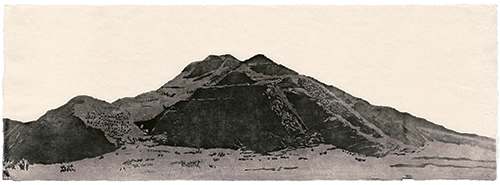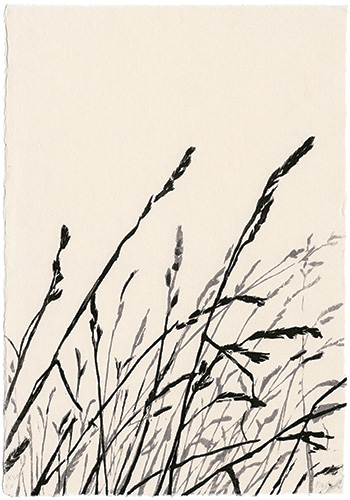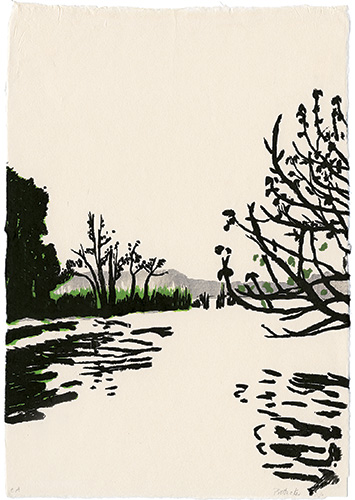
|
Mountains and Rivers
By Friedrich Dimmling
Even as a child, printmaking fascinated Eva Pietzcker, the almost
magical emergence of an image as the paper is pulled from the block. Clearly,
it has been a long journey leading to her current masterpieces of Japanese woodblock
prints, images which, with their intense calm power, prompt a comparison to
those of such artists as 趙孟頫 Zhao Mengfu of the Yuan dynasty. What has been
said about his contemporary, the Daoist 方從義 Fang Congyi, applies just as well
to Eva Pietzcker’s work: “He painted landscapes which gave form to the formless
and which transformed the formed into an existence beyond form.” ›Mountains and Rivers‹, 山川 shan chuan, is the
Chinese Term for landscape. As mountains and rivers—or their absence—form a landscape’s
character, so the rocks and water levels in Eva Pietzcker’s prints give hints to the
magical presence of the captured sceneries.
Eva Pietzcker, who was born in Tübingen in 1966, studied Fine
Art at the Akademie der Bildenden Künste in Nürnberg from 1987 until 1992, and
then at the Hochschule der Künste in Berlin. Since 1991 she has worked as a
free-lance artist in Berlin with a focus on printmaking, initially working on
etchings and screen prints. With her discovery of the Japanese style of woodblock
printmaking she found her true medium. About this technique she writes: ”Compared
to the Western method, where oil-based ink, applied to the block with a roller,
is printed onto the paper's surface with the help of a press, in the Japanese
style, watercolor paint is applied to the block with brushes and printed by
hand allowing the color to seep deep into the soft Japanese paper. As a result,
these Japanese style prints tend to have a more painterly appearance and can
often resemble watercolor paintings.”
This technique lends itself well to the art of landscape painting,
which quickly became the major theme of Eva Pietzcker's work. From her images, qualities of deep stillness and intense expression emerge. The creation of these
prints happens in two stages. On location, often after hours of searching for
the perfect view, sometimes sitting in a small boat on a lake, a water-color
drawing is created by quick sketching. Sometimes it is like a race with the
light, as it changes from one moment to the next. Afterwards, at home in the
studio, the plates are cut requiring high precision and quiet concentration
in an atmosphere of meditative focus. The communion of these two poles: the
lightning-fast sketching of a fleeting mood without room for calculating thoughts,
and then the process of translation through the cutting of the blocks with absolute
concentration and free from distraction - these are the outer processes by
which these works of mysterious and fascinating effect are created.
I first came to know Eva Pietzcker's work in a small gallery
in Berlin Kreuzberg. More specifically, it was on an invitation card for the
opening which featured an etching by Eva Pietzcker, chosen by the gallery owner
with the assumption that it's overwhelming impression would attract visitors
to the gallery. It was a true “Oh wow!” experience. The card accomplished its
mission. I visited the show – and I purchased the print.
Now if I ponder the question, what is it that so fascinates the viewer about Eva's prints, that literally pulls the viewer in, I find myself in some tricky
territory. For experts it is easy to talk about art, so long as they assess
the technique, classify the style, or explain the artist’s contribution to the
genre. Certainly technical mastery contributes to the impact of the work, showing
itself in the complex multi-color woodblock prints with their hairline contours,
impressive even to the layperson. Yet the impact on the viewer is no less strong
in the works which appear, on the surface, to be more simple. Moreover, modern
day observers have so come to expect perfection in art that they would rather
comment on its absence than appreciate its presence. The impact of Eva’s work
on the viewer has perhaps more to do with that transcendent dimension which
distinguishes true works of art from those which only strive to be. To say something
of substance about this is difficult for a person of these rationally-oriented
times. A woodblock print is an image, whereas our modern language – with the
exception of poetry of course – is more specifically suited, through the use
of well-defined terms, for depicting objective connections. So for this question
a poem may be helpful, perhaps one of the legendary poems from the Tang period,
famous for their natural ambiance.
白日依山盡,
黃河入海流。
欲窮千里目,
更上一層樓。
On the tower
A radiant sun sinks slowly behind the distant mountains.
There, the yellow river that pours out into the sea.
Do you wish to see further still?
Then climb up to the next level.
Eva has long put the spirit of this poem's conclusion, which
has become a common expression in Chinese, into action with both passion and
curiosity: studies of Japanese woodblock printmaking in Japan and research of
the traditional Chinese methods both in 2003; studies into Japanese paper-making
in 2004; working with porcelain in China in 2009; and several work stays in
the USA and Canada. Eva Pietzcker constantly strives for a more complete understanding.
Without the remarkable level of dedication and deep exploration that she shows,
perfection within this challenging technique could hardly be achieved.
To explore the mystery of the transcendental dimension mentioned
above, I want to approach this theme from the Asian side. The main advantage
of this approach is that the ominous term of transcendence, so easy to define
yet so difficult to comprehend, becomes less intimidating because it is non-representational.
Our understanding of transcendence, as something that lies a priori beyond the
possibility of sensual experience, exists only in Western culture. The rest
of the world, especially Asia, knows only one world. The cosmos as it is understood
in Chinese culture, and here I refer to the cultural region broadly, is a world
of appearances. This is most clear in the Chinese language itself where the
written language is image. And it was not without reason that the Japanese language
did not abandon the use of Chinese characters.
This approach, the rejection of clearly defined terms in favor
of a pictorial script, as the starting point for an intellectual understanding
of a subject, however, has its price. We end up with terms, which have become
popular in the West, such as 道 Dao, the Way, which stands for the primordial
nature of a thing or a person. Or we come upon statements such as 大象无形 “The
perfect image has no form”, which we feel we can almost understand, but which
then, because of their elusiveness, leave us perplexed in the end. To avoid
being accused of esoteric ramblings, I should note here that Chinese terms always
appeal to the reader's own horizon of experience. The reader, based on her own
experience or literary knowledge, must already have or must develop her own
understanding of the characters. The pictorial script lacks the objectivity
of our terms, which are advantageous for interpersonal communication, but in
return it opens a pathway into worlds which remain inaccessible in the case
of objectivity.
It is the greater directness of this approach which enables
written characters to successfully convey meanings, just as it enables images
to have their intense emotional impact on a viewer. This jaunt into the particularities
of Asian and especially Chinese culture can be justified because of the clear
echoes in Eva Pietzcker's woodblock prints of the Asian world and because of
the artist’s deep interest in Chinese and Japanese culture, and especially in
its Arts. It is not only the technique itself, the Japanese way of woodblock
printmaking, but also the main theme of her work, nature, including its sometimes
less spectacular aspects which still leave a deep impression on the human soul,
and whose essence she inimitably captures in her work.
To follow this essential idea still further, I want to incorporate
the approach sketched above and rely upon the image language of the Yi Jing
(I Ching). This ancient Chinese work known as the “Book of Changes”, interprets
the world of phenomena through 64 images. Each image is composed of two out
of eight possible trigrams. The term trigram refers to their make-up of three
lines, each either continuous or interrupted, which represent the yang or yin
character depending upon their relative positions. Some trigrams evoke images
of nature which in turn lead to related insights. It is these trigram symbols
that may now be helpful in bringing the essence of an image closer to the realm
of conceptual understanding.
  The Standstill, the Mountain
The Standstill, the Mountain

The Yang line has come to the end of its ascendancy and arrives
there at its standstill. An unfolding, a creating force, has come to its completion,
has taken, at least temporarily, its ultimate form.
  The Gentle Penetration, the Wind
The Gentle Penetration, the Wind

A Yin Line pushes up from below into a purely Yang constellation.
The Soft takes hold of the Solid and transforms it. A gentle breeze brings grain
stalks into movement, transforming the seemingly lifeless and still grasses
into an undulating ocean.
  The Joyous, the Lake
The Joyous, the Lake

Benignly radiant, the lake's surface lies before the viewer,
a peaceful and joyous image. The Soft, the Yin, is on the surface and defines
the image, which otherwise consists of only solid Yang lines. In contrast to
the first example, the Mountain, here the supple water, which cannot take a
solid form, shapes the surface rather than the hard rocks with their bizarre
forms.
Perhaps this exploration of Eva Pietzcker's block prints through
the lens of the Book of Changes has brought you further into her images, possibly
even left you, in some small way, changed by them. The Chinese term for the study
of a painting, 读画 du hua, when translated literally, means “to read the image”. In this
sense I wish the observer a fascinating, joyous, and horizon-expanding reading
of her work.
Berlin, February 2013
 |
 |